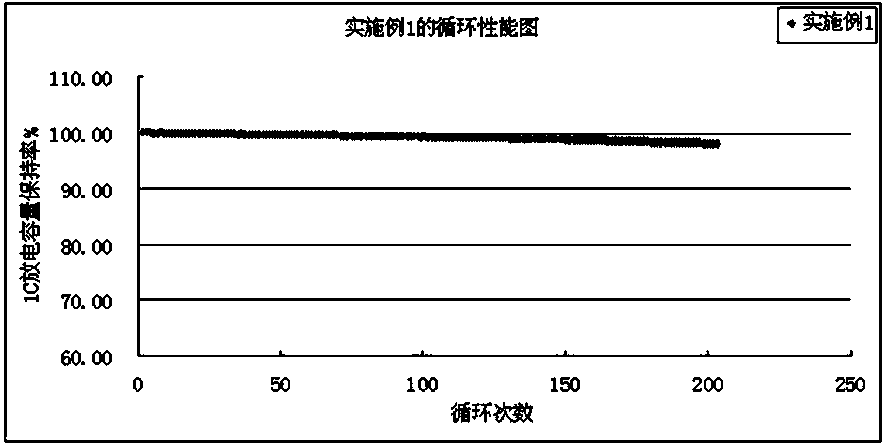Method for producing high-capacity 18650 lithium ion battery
A technology of lithium-ion batteries and manufacturing methods, which is applied in the manufacture of electrolyte batteries, battery electrodes, secondary batteries, etc., can solve the problems of low capacity, high cost, and poor cycle stability of lithium cobalt oxide, and achieve high capacity, low cost, and The effect of high discharge specific capacity
- Summary
- Abstract
- Description
- Claims
- Application Information
AI Technical Summary
Problems solved by technology
Method used
Image
Examples
Embodiment 1
[0031] 1) Lithium cobalt oxide and ternary cathode material LiNi 0.5 co 0.2 mn 0.3 o 2 The mass ratio of the two positive electrode active materials is 1:4, and the mass percentage of the two positive electrode active materials is 97%, then weigh 1.3% of SP, 0.2% of KS-6, and 1.5% of polyvinylidene fluoride PVDFHSV900, and dry mix the above materials method to prepare positive electrode slurry. Coat the positive electrode slurry on a metal aluminum foil with a thickness of 16 μm to obtain a positive electrode sheet, place the positive electrode sheet in an oven at 80-105°C and vacuum-dry it, and roll it into a positive electrode sheet with a thickness of 0.138±2mm. Then, it is cut into pieces, divided into strips, welded with tabs, and glued to make a positive electrode sheet for use.
[0032] 2) 95% by mass of artificial graphite powder, 1.5% of CNT, 1.5% of carboxymethyl cellulose CMC and 2% of SBR were used to dry mix the above materials to make negative electrode slurr...
Embodiment 2
[0036] 1) Lithium cobalt oxide and ternary cathode material LiNi 0.6 co 0.2 mn 0.2 o 2 The mass ratio of the two positive electrode active materials is 3:7, and the mass percentage of the two positive electrode active materials is 96.5%, and then weigh 1.3% of SP, 0.2% of KS-6, and 2% of polyvinylidene fluoride PVDF HSV900, and mix the above materials according to dry Mixing method to make positive electrode slurry. Coat the positive electrode slurry on a metal aluminum foil with a thickness of 16 μm to obtain a positive electrode sheet, place the positive electrode sheet in an oven at 80-105°C and vacuum-dry it, and roll it into a positive electrode sheet with a thickness of 0.140±2mm. Then cut into pieces, divide into strips, weld the tabs, and paste the glue to make the positive electrode sheet of the battery cell for use.
[0037] 2) 95.5% by mass of artificial graphite powder, 1% of CNT, 1.5% of carboxymethyl cellulose CMC and 2% of SBR, and the above materials were m...
Embodiment 3
[0041] 1) Lithium cobalt oxide and ternary cathode material LiNi 0.6 co 0.2 mn 0.2 o 2 The mass ratio of the two positive electrode active materials is 2:3, and the mass percentage of the two positive electrode active materials is 97%, and then weigh 0.8% of SP, 0.2% of KS-6, and 2% of polyvinylidene fluoride PVDF HSV900. Mixing method to make positive electrode slurry. Coat the positive electrode slurry on a metal aluminum foil with a thickness of 16 μm to obtain a positive electrode sheet, place the positive electrode sheet in an oven at 80-105°C and vacuum-dry it, and roll it into a positive electrode sheet with a thickness of 0.140±2mm. Then cut into pieces, divide into strips, weld the tabs, and paste the glue to make the positive electrode sheet of the battery cell for use.
[0042] 2) The artificial graphite powder with a mass percentage of 96%, 0.5% CNT, 1% carboxymethyl cellulose CMC and 2.5% SBR were used to make negative electrode slurry by dry mixing the above ...
PUM
 Login to View More
Login to View More Abstract
Description
Claims
Application Information
 Login to View More
Login to View More - R&D
- Intellectual Property
- Life Sciences
- Materials
- Tech Scout
- Unparalleled Data Quality
- Higher Quality Content
- 60% Fewer Hallucinations
Browse by: Latest US Patents, China's latest patents, Technical Efficacy Thesaurus, Application Domain, Technology Topic, Popular Technical Reports.
© 2025 PatSnap. All rights reserved.Legal|Privacy policy|Modern Slavery Act Transparency Statement|Sitemap|About US| Contact US: help@patsnap.com

